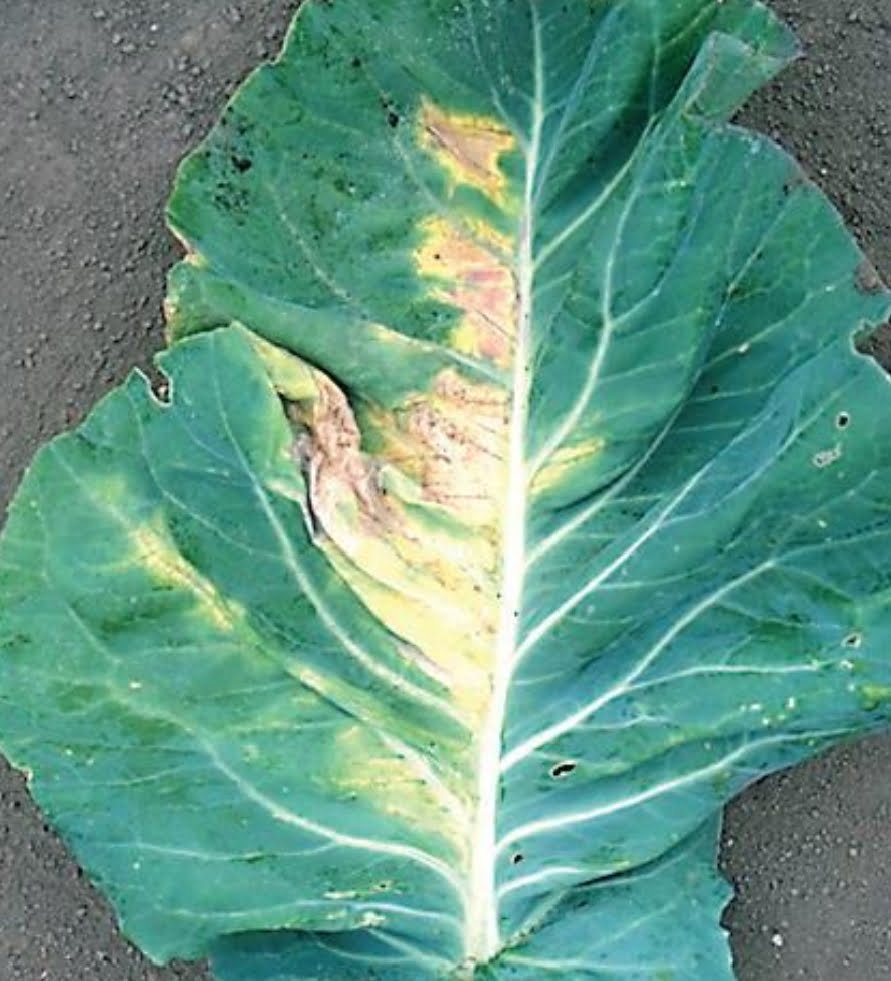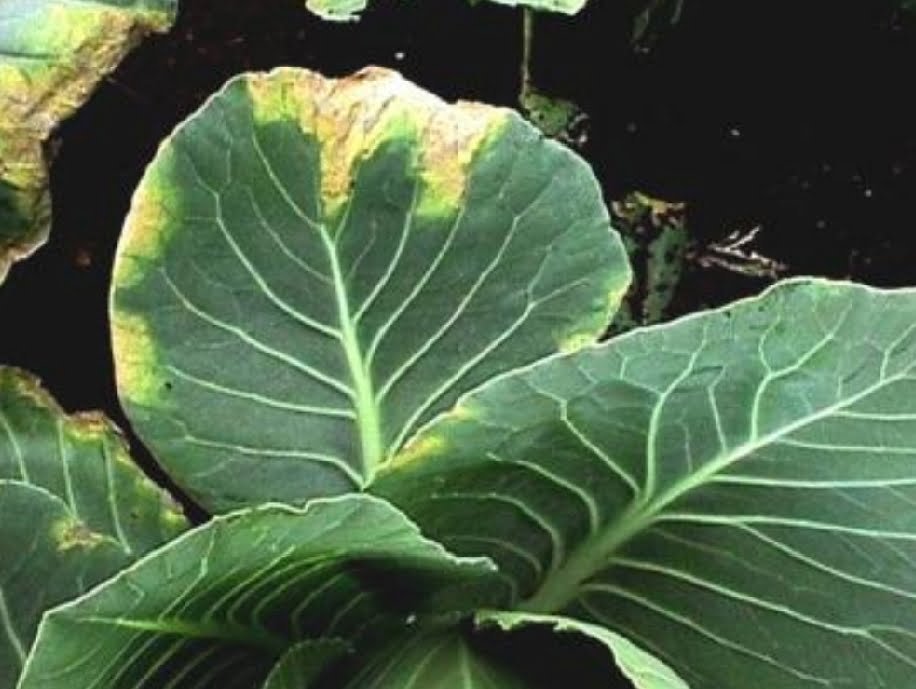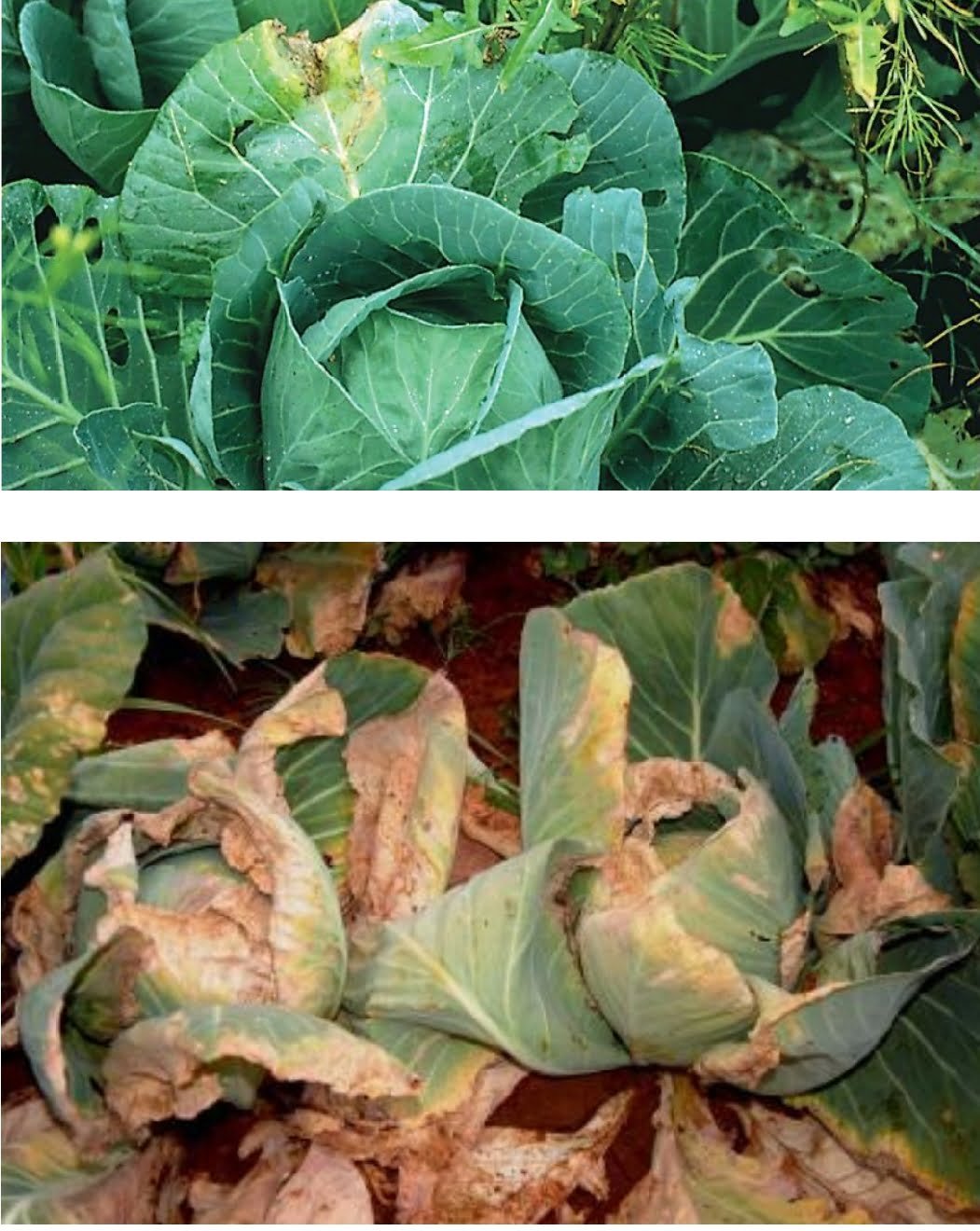Table of contents of the article
ToggleBlack mold on cabbage and cauliflower is a bacterial disease that affects the quality of the crop and its marketability. In this article from the “WORLD OF PLANTS” website, we review the symptoms of infection, its causes, and how to prevent and control it.
Identification of black rot on cabbage and cauliflower
It is considered the most dangerous disease worldwide for cabbage plants and can infect most cabbage crops and at any stage of growth. This disease is difficult for farmers to manage. The disease can cause significant crop losses when conditions are warm, humid after periods of rainy weather and spreads rapidly.
Black mold is caused by the bacteria, Xanthomonas campestris PV.campestris; The suitable conditions for growth are between 25-30°C with high humidity
Symptoms of black mold on cabbage and cauliflower
Symptoms of black mold vary depending on the affected plant and environmental conditions, and the bacteria can enter plants through natural openings and wounds caused by mechanical injury to the roots and leaves.
Infected seeds also cause infection in seedlings, and often no symptoms appear on infected seedlings that grow in low temperature conditions (less than 15-18 °C). When infected seedlings are planted in the field and temperatures rise to 25-30 °C and in the presence of high relative humidity (80 -100%), the infection appears severe.
In older plants, the symptoms of the disease often appear in the form of yellow or dry tissue on the edges of the leaves, in the form of leaf edge burning, and then the infection develops into a V-shape with a base usually directed along the veins.
Careful examination of infected leaves and stems may reveal black veins in the affected tissue, which is the reason for the name of this disease.
Infected areas on the leaves can expand toward the base of the leaf, causing the leaf to wilt and die.
The bacteria produce sticky polysaccharides called xanthan that clog the vascular bundles, causing them to collapse and turn black. The tissue above the affected vessels turns yellow, dries up, and dies. During warm, moist environmental conditions, bacteria can move from the leaf to the stem, and the bacteria can then travel up or down the stem to other parts of the plant, including the roots.
Yellowing may be seen in infected plants anywhere on the leaf.
In root vegetables, such as radishes, symptoms may not appear on the leaves, but black discoloration of the vascular tissue can appear within the edible root tissue, making the plants unmarketable.
Although some infected plants may appear healthy, a section on the affected stem reveals damage to the vascular tissue.
Some of the symptoms of black rot are very similar to those caused by Fusarium yellows, which causes the vascular tissue to turn brown rather than black. Most commercial cruciferous varieties are resistant to Fusarium.



Spread of black mold on cabbage and cauliflower
Seeds contaminated with black mold bacteria are the most important source of the disease and contribute significantly to the spread of this disease. The presence of three infected seeds out of 10,000 seeds is sufficient for a severe spread of the disease to occur.
Bacteria live in infected plant waste and remain there until the infected tissue decomposes (it can take up to two years). However, in soil, bacteria do not live for a long time as living organisms (several weeks).
Black mold bacteria can also infect and survive on many cruciferous weeds and thus contribute to the persistence and spread of this disease.
It can grow and reproduce on the host's tissues without causing symptoms.
The main way black rot disease spreads on cabbage and cauliflower is in the field
Bacteria present in infected plant residues, in the soil, or from diseased plants adjacent to healthy plants are spread through rainwater, water spraying, or overhead irrigation, and thus the infection spreads throughout the field.
Bacteria enter and exit from infected plant leaves through special glands located at the end of the vascular bundles through which water is excreted. They are called hydathodes and are located at the edges of the leaves. They often emerge from them during periods of high humidity in the morning.
The pathogen spreads very quickly when raindrops contaminated with bacteria fall on healthy leaves and enters the leaf glands again when the humidity in the air decreases.
After entering the leaves, the bacteria move to the vascular bundles and begin to multiply and cause damage.
Black mold infestation is most severe in fields that receive frequent early morning rains. Equipment, workers, and animals can spread the disease. Insects can also spread the bacteria. However, their contribution to the spread of black mold is limited.
Management of black mold disease on cabbage and cauliflower
Managing black mold begins with an Integrated Pest Management (IPM) strategy including:
- Cultivation of resistant varieties.
- Planting certified, disease-free seeds.
- Cultivation of healthy seedlings developed from disease-free seeds.
- Good soil drainage.
- Agricultural cycle.
- Seed disinfection.
- Reducing plant density and planting according to the specified distances for each crop.
- Getting rid of weeds.
- Avoid planting late-maturing varieties in areas where there is a fear of infection
Treating seeds infected with black mold on cabbage and cauliflower
Infected seeds contribute significantly to the spread of black mold bacteria and growers should only plant certified seeds with <1 infected seed per 30,000 or 0.003% of contamination.
When the level of seed infection is not known or disease-free seeds are not available, the seeds must be treated to eliminate bacteria. Seed treatment does not remove 100% of the bacteria present in the seeds, and may negatively affect seed germination and activity. Seeds can be soaked in hot water at 50 degrees. Celsius for 25 minutes for cabbage, 20 minutes for cauliflower and turnip, and 15 minutes for mustard and arugula. It is the most effective treatment for controlling black mold in seeds, weak seeds, seeds stored for several years, and seeds of some cruciferous crops. For example, cauliflower, cabbage, kale may be damaged by hot water treatment where they are soaked for only 15 minutes at only 50°C.
Avoid spreading black mold disease on cabbage and cauliflower
- Use new seed trays every year to avoid contamination of the new crop with black mold bacteria. The trays used can be sterilized with boiling water or chemical disinfectants to get rid of possible contamination. Contaminated seed trays must be disposed of to prevent the spread of the disease to other seedling trays.
- Avoid soaking bundles of seedlings grown in basins of water before planting, as black mold bacteria can spread from diseased seedlings to healthy ones through wounds on the roots when immersed in water.
- Do not move between wet crops and restrict field work while the fields are dry to reduce the spread of the disease, as black mold bacteria can be transmitted from contamination of clothing, equipment, tools and water sources.
- Planting with the specific agricultural distances for each crop and not increasing the plant density to enhance air movement between the plants and between the planting rows to facilitate the drying of the plants.
- Watering in the morning so that the plants dry quickly before sunset.
- Wash and disinfect equipment before moving from one field to another.
- The cultivated field must be far from the fields cultivated for cabbage crops in the previous year.
- The soil must be well-drained and not receive running water from fields where cabbage crops were previously grown.
- Light yellow, well-drained soil is best for producing cabbage vegetables because it can be worked early in the season, facilitates early planting, and early planting helps avoid environmental conditions that are conducive to the growth and spread of black mold bacteria.
The agricultural cycle is for a period of not less than 3 years
Planting disease-free seeds, treated seeds, or planting healthy seedlings does not necessarily guarantee a disease-free crop in the field.
The agricultural cycle is also an important management tool.
Black mold bacteria can live in the infected crop tissue in the soil until the infected crop tissue decomposes and rots. The time required for the decomposition of cruciferous residues varies between regions depending on the temperature, the amount of soil moisture, and the type of soil. For example:
Under long, warm summer conditions, the bacteria can live for approximately 60 days in soil, and up to 615 days in infected waste. Bacteria can live longer in the soil during cold and wet seasons than during dry seasons.
Weed control
Black mold bacteria can infect and live on many cruciferous weeds. The disease spreads from weeds to cruciferous crops. The bacteria can survive on weed seeds and can grow and reproduce on weed leaves without causing disease. Good control of weeds within fields will help in disease management.
pest control
The flea beetle (Phyllotreta cruciferae) can transfer black mold bacteria from infected plants to healthy plants. However, its importance in the spread of the disease is limited. Wounds caused by insects provide an entry point for the disease to infect plants during heavy meteor showers or periods of rain. Pest control will help reduce the spread and severity of the disease.
Crop nutrition
A balanced fertilization program reduces plants’ susceptibility to diseases, and excess nitrogen enhances vegetative growth and may increase plants’ susceptibility to infection. Research indicates that micronutrients may also participate in disease defense mechanisms for cruciferous crops.
Chemotherapy
Spraying with copper compounds can only be used for prevention in nurseries
After planting in the field, the use of copper compounds did not give positive results to control black mold. The results showed that the concentration of copper used by spraying is very low and is unable to control bacteria in case of infection, and that increasing the concentration of copper causes burns to the leaves, and applying copper to plants can be beneficial in the event of infection. Plants are exposed to mechanical wounds to prevent infection.
In conclusion, we would like to note that we, at the world of plants website, offer you all the necessary services in the world of plants, we provide all farmers and those interested in plants with three main services::-
- Artificial intelligence consulting service to help you identify diseases that affect plants and how to deal with them.
- Blog about plants, plant diseases and care of various crops ... You are currently browsing one of her articles right now.
- An application that provides agricultural consultations to clients, as well as a service for imaging diseases and knowing their treatment for free – Click to download the Android version from Google Play Store، Click to download the IOS version from the Apple App Store.
References:
Michael Celetti – Horticulture Crops Program/OMAFRA; Kristen Callow – Vegetable Crop Specialist/OMAFRA, Black Rot of Crucifer Crops
Alvarez AM. “Black rot of crucifers.” In: Slusarenko AJ, Fraser RSS, van Loon LC (Eds.) Mechanisms of Resistance to Plant Diseases. Dordrecht, The Netherlands: Kluwer Academic Publishers, 2000. pp. 21-52.




